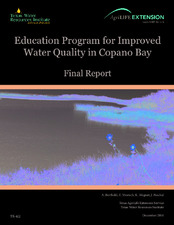| dc.description.abstract | The Copano Bay watershed covers approximately 1.4 million acres encompassing portions of Karnes, Bee, Goliad, Refugio, San Patricio and Aransas counties. Copano Bay and its main tributaries, the Mission and Aransas rivers, were placed on the Texas Commission on Environmental Quality (TCEQ) 303(d) list in 1998 due to levels of bacteria that exceed water quality standards established to protect oyster waters use. A Total Maximum Daily Load (TMDL) program was initiated in September 2003 to identify and assess sources of these bacteria. The Center for Research in Water Resources at the University of Texas at Austin (UT CRWR) was funded by TCEQ to conduct computer-based modeling to determine the bacterial loading and reductions necessary to attain water quality standards. Subsequently Texas A&M University-Corpus Christi (TAMU-CC) conducted bacterial source tracking (BST) with funding from Texas General Land Office (TGLO) and the Coastal Bend Bays and Estuaries Program (CBBEP) to determine actual sources of bacteria.
Due to the findings of the initial efforts of the TMDL and concerns voiced by stakeholders in the watershed, Texas AgriLife Extension Service was awarded a Clean Water Act § 319(h) Nonpoint Source Grant from the Texas State Soil and Water Conservation Board (TSSWCB) and the U.S. Environmental Protection Agency. The overall goal of this project was to improve water quality in Copano Bay and its tributaries by increasing awareness of water quality issues throughout the watershed. This increased awareness was to be accomplished by providing education and demonstrations for land and livestock owners in the watershed on best management practices (BMPs) to decrease or prevent bacteria from entering waterways.
Through creation of a project website, 52 educational programs, and nine one-on-one consultations over the span of the project, we have reached 5,408 residents in and around the Copano Bay watershed. Additionally, through this project all data collected for the initial TMDL efforts was re-evaluated and findings were presented in the “Task 2 Report.” Project members developed a curriculum for horse owners, “A Guide to Good Horsekeeping” that addressed BMPs specific to horse operations. Land and livestock owners who had already implemented BMPs or were interested in implementing BMPs were given a participation certificate. | en |


